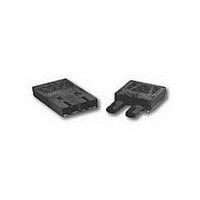HFBR-5803AT Avago Technologies US Inc., HFBR-5803AT Datasheet - Page 5

HFBR-5803AT
Manufacturer Part Number
HFBR-5803AT
Description
Manufacturer
Avago Technologies US Inc.
Datasheet
1.HFBR-5803AT.pdf
(15 pages)
Specifications of HFBR-5803AT
Optical Fiber Type
TX/RX
Data Transfer Rate
100Mbps
Optical Rise Time
3/2.2ns
Optical Fall Time
3/2.2ns
Jitter
0.69/2.14ns
Operating Temperature Classification
Commercial
Peak Wavelength
1308/1380nm
Operating Supply Voltage (min)
4.75V
Operating Supply Voltage (typ)
5V
Operating Supply Voltage (max)
5.25V
Output Current
50mA
Operating Temp Range
-10C to 85C
Mounting
Screw
Pin Count
9
Lead Free Status / Rohs Status
Not Compliant
Application Information
The Applications Engineering group in the Avago Tech-
nologies Fiber Optics Communication Division is avail-
able to assist you with the technical understanding and
design trade-offs associated with these transceivers.
You can contact them through your Avago Technolo-
gies’ sales representative.
The following information is provided to answer some
of the most common questions about the use of these
parts.
Transceiver Optical Power Budget versus Link Length
Optical Power Budget (OPB) is the available optical
power for a fiber optic link to accommodate fiber cable
losses plus losses due to in-line connectors, splices, op-
tical switches, and to provide margin for link aging and
unplanned losses due to cable plant reconfiguration or
repair.
Figure 4 illustrates the predicted OPB associated with
the transceiver series specified in this data sheet at the
Beginning of Life (BOL). These curves represent the at-
tenuation and chromatic plus modal dispersion losses
associated with the 62.5/125 µm and 50/125 µm fiber
cables only. The area under the curves represents the
remaining OPB at any link length, which is available for
overcoming non-fiber cable related losses.
Avago Technologies’ LED technology has produced
1300 nm LED devices with lower aging characteristics
than normally associated with these technologies in
the industry. The industry convention is 1.5 dB aging for
1300 nm LEDs. The Avago Technologies 1300 nm LEDs
will experience less than 1 dB of aging over normal com-
mercial equipment mission life periods. Contact your
Avago Technologies’ sales representative for additional
details.
Figure 4 was generated with a Avago Technologies fiber
optic link model containing the current industry con-
ventions for fiber cable specifications and the FDDI PMD
and LCF-PMD optical parameters. These parameters are
reflected in the guaranteed performance of the trans-
ceiver specifications in this data sheet. This same model
has been used extensively in the ANSI and IEEE commit-
tees, including the ANSI X3T9.5 committee, to establish
the optical performance requirements for various fiber
optic interface standards. The cable parameters used
come from the ISO/IEC JTC1/SC 25/WG3 Generic Ca-
bling for Customer Premises per DIS 11801 document
and the EIA/TIA-568-A Commercial Building Telecom-
munications Cabling Standard per SP-2840.
Transceiver Signaling Operating Rate Range and BER Per-
formance
For purposes of definition, the symbol (Baud) rate, also
called signaling rate, is the reciprocal of the shortest
symbol time. Data rate (bits/sec) is the symbol rate di-
5
vided by the encoding factor used to encode the data
(symbols/bit).
Figure 4. Optical Power Budget at BOL versus Fiber Optic Cable
Length.
When used in Fast Ethernet, FDDI and ATM 100 Mb/s ap-
plications the performance of the 1300 nm transceivers
is guaranteed over the signaling rate of 10 MBd to 125
MBd to the full conditions listed in individual product
specification tables.
Figure 5. Transceiver Relative Optical Power Budget at Constant
BER vs. Signaling Rate.
The transceivers may be used for other applications at
signaling rates outside of the 10 MBd to 125 MBd range
with some penalty in the link optical power budget
primarily caused by a reduction of receiver sensitivity.
Figure 5 gives an indication of the typical performance
of these 1300 nm products at different rates.
These transceivers can also be used for applications
which require different Bit Error Rate (BER) performance.
Figure 6 illustrates the typical trade-off between link BER
and the receivers input optical power level.
12
10
8
6
4
2
0
2.5
2.0
1.5
1.0
0.5
0.5
0
CONDITIONS:
1. PRBS 2
2. DATA SAMPLED AT CENTER OF DATA SYMBOL.
3. BER = 10
4. T
5. V
6. INPUT OPTICAL RISE/FALL TIMES = 1.0/2.1 ns.
0
0.3
FIBER OPTIC CABLE LENGTH (km)
A
CC
25
= +25˚ C
= 3.3 V to 5 V dc
0.5
7
-1
HFBR-5803, 62.5/125 µm
50
-6
SIGNAL RATE (MBd)
1.
0
75
HFBR-5803
50/125 µm
100
1.5
125
150
2.0
175
2.5
200





















